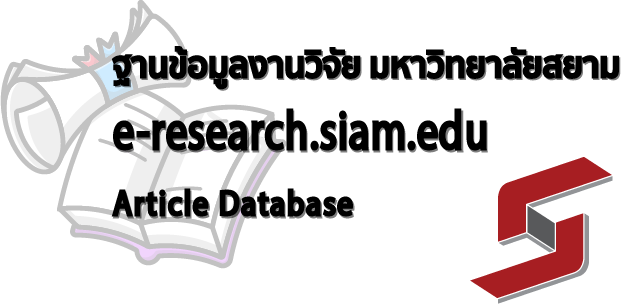- KB Home
- หลักสูตรปริญญาตรี|Bachelor Degree
- คณะเภสัชศาสตร์
- Association Between Glutathione S-Transferase M1, T1 Polymorphisms and Clinical Outcomes Among Thai Breast Cancer Patients
| Research Report: | Association Between Glutathione S-Transferase M1, T1 Polymorphisms and Clinical Outcomes Among Thai Breast Cancer Patients |
| Author: | Phakarat Tangkheunkan, Kitiphong Harncharoen, Somchai Thanasitthichai, Danai Tiwawech |
| Email: | phakarat.tan@siam.edu |
| Department|Faculty: | Faculty of Pharmacy, Siam University, Bangkok 10160 |
| Published: | Research Report Association Between Glutathione S-Transferase M1, T1 Polymorphisms and Clinical Outcomes Among Thai Breast Cancer Patients |
Citation
Tangkheunkan P., Harncharoen K, Thanasitthichai S. & Tiwawech D. (2021). Association between glutathione S-Transferase M1, T1 Polymorphisms and clinical outcomes among Thai Breast cancer patients. (Research Report). Bangkok: Faculty of Pharmacy, Siam University.
ABSTRACT
Glutathione S-transferase M1 and T1 (GSTM1 and GSTT1) are the enzymes that play a key role in the detoxification of a broad range of xenobiotics, including chemotherapeutic drugs. The deletion polymorphisms of GSTM1 and GSTT1 genes are associated with reduced enzyme activity that could be related to clinical outcomes of chemotherapeutic agents in breast cancer. However, they have yielded inconsistent results and there is limited information among Thai patients. Therefore, the objective of this research is to explore the role of GSTM1, GSTT1 polymorphisms on clinical outcomes among Thai patients with breast cancer treated with chemotherapy.
The retrospective study was conducted to evaluate the toxicity and survival among breast cancer patients with chemotherapy. Fifty six patients who had received complete course of anthracycline based chemotherapy were evaluated for hematotoxicity according to the CTCAE v3.0. The prevalence of the grades was as follows: 38 anemia (67.90%), 38 leucopenia (67.90%), 10 neutropenia (17.90%) and 3 thrombocytopenia (5.40%) and grade 4 hematotoxicity and toxic deaths were not observed in this study. There were no significant association between GSTM1 and GSTT1 polymorphisms and hematotoxicity (p = 0.36, 0.34, 0.25 and 0.19). With respect to survival study, the frequency of the GSTM1 and GSTT1 null genotype in 198 breast cancer patients was 65.70% and 33.30%, respectively. The statistically significant association between the GSTM1 null genotype and the tumor stage was found after adjusted for age at diagnosis alone, progesterone receptor status alone and age at diagnosis and progesterone receptor status (P = 0.043, 0.047, and 0.037). For GSTT1, statistically significant association between the GSTT1 null genotype and the tumor size was found (OR = 0.51, 0.03). The overall survival at 1, 3, 5 years was 95.00%, 83.00%, 71.00% respectively. The log rank test and Cox proportional hazards revealed a significant different in the 5-year overall survival according to lymph node metastasis and tumor stage (P = 0.014 and P < 0.001). No associations between overall survival and GSTM1 or GSTT1 genotype were found in single genotype or combined genotypes analyses (P = 0.76, 0.15). This result provided the epidemiological and pharmacogenetic information to use in developing treatment guideline and prognostic of hematotoxicity and survival of chemotherapy.
Keywords: GSTM1, GSTT1, polymorphism, clinical outcomes.
การศึกษาภาวะสมดุลแคลเซียมและพฤติกรรมการเรียนรู้ของหนูขาวที่ได้รับการเสริมแคลเซียม|Effects of calcium supplement on calcium homeostasis and learning-related behaviors in rats
Faculty of Pharmacy, Siam University, Bangkok, Thailand


